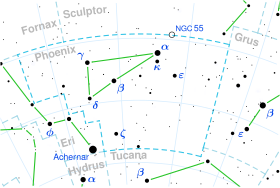Lambda1 Phoenicis
Appearance
| Observation data Epoch J2000 Equinox J2000 | |
|---|---|
| Constellation | Phoenix |
| Right ascension | 00h 31m 24.98046s[1] |
| Declination | −48° 48′ 12.6538″[1] |
| Apparent magnitude (V) | 4.76[2] |
| Characteristics | |
| Spectral type | A0V[3] |
| U−B color index | +0.04[4] |
| B−V color index | +0.02[4] |
| Astrometry | |
| Radial velocity (Rv) | -2.00[5] km/s |
| Proper motion (μ) | RA: +140.49[1] mas/yr Dec.: +19.25[1] mas/yr |
| Parallax (π) | 18.88 ± 0.24 mas[1] |
| Distance | 173 ± 2 ly (53.0 ± 0.7 pc) |
| Absolute magnitude (MV) | 1.14[2] |
| Details | |
| Mass | 2.26[6] M☉ |
| Luminosity | 33.68[2] L☉ |
| Surface gravity (log g) | 4.17[6] cgs |
| Temperature | 9,931[6] K |
| Metallicity [Fe/H] | 0.00[7] dex |
| Rotational velocity (v sin i) | 111[6] km/s |
| Other designations | |
| Database references | |
| SIMBAD | data |
Lambda1 Phoenicis (λ1 Phe) is a class A0V[3] (white main-sequence) star in the constellation Phoenix. Its apparent magnitude is 4.76[2] and it is approximately 173 light years away based on parallax.[1]
It has one companion at a distance of about 30" and magnitude 13.7.[8][3]
References
- ^ a b c d e f Van Leeuwen, F. (2007). "Validation of the new Hipparcos reduction". Astronomy and Astrophysics. 474 (2): 653. arXiv:0708.1752. Bibcode:2007A&A...474..653V. doi:10.1051/0004-6361:20078357. Vizier catalog entry
- ^ a b c d Anderson, E.; Francis, Ch. (2012). "XHIP: An extended hipparcos compilation". Astronomy Letters. 38 (5): 331. arXiv:1108.4971. Bibcode:2012AstL...38..331A. doi:10.1134/S1063773712050015. Vizier catalog entry
- ^ a b c Mason, Brian D.; Wycoff, Gary L.; Hartkopf, William I.; Douglass, Geoffrey G.; Worley, Charles E. (2001). "The 2001 US Naval Observatory Double Star CD-ROM. I. The Washington Double Star Catalog". The Astronomical Journal. 122 (6): 3466. Bibcode:2001AJ....122.3466M. doi:10.1086/323920. Vizier catalog entry
- ^ a b Mallama, A. (2014). "Sloan Magnitudes for the Brightest Stars". The Journal of the American Association of Variable Star Observers. 42: 443. Bibcode:2014JAVSO..42..443M.Vizier catalog entry
- ^ Gontcharov, G. A. (2006). "Pulkovo Compilation of Radial Velocities for 35 495 Hipparcos stars in a common system". Astronomy Letters. 32 (11): 759. arXiv:1606.08053. Bibcode:2006AstL...32..759G. doi:10.1134/S1063773706110065.
- ^ a b c d David, Trevor J.; Hillenbrand, Lynne A. (2015). "The Ages of Early-Type Stars: Strömgren Photometric Methods Calibrated, Validated, Tested, and Applied to Hosts and Prospective Hosts of Directly Imaged Exoplanets". The Astrophysical Journal. 804 (2): 146. arXiv:1501.03154. Bibcode:2015ApJ...804..146D. doi:10.1088/0004-637X/804/2/146. Vizier catalog entry
- ^ Gontcharov, G. A. (2012). "Dependence of kinematics on the age of stars in the solar neighborhood". Astronomy Letters. 38 (12): 771. arXiv:1606.08814. Bibcode:2012AstL...38..771G. doi:10.1134/S1063773712120031. Vizier catalog entry
- ^ Dommanget, J.; Nys, O. (2002). "VizieR Online Data Catalog: CCDM (Catalog of Components of Double & Multiple stars) (Dommanget+ 2002)". VizieR On-line Data Catalog: I/274. Originally published in: Observations et Travaux 54. 1274. Bibcode:2002yCat.1274....0D. Vizier catalog entry

